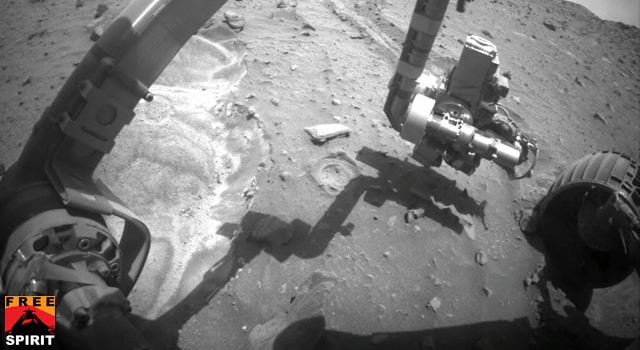[/caption] To prepare for an actual attempt to extract the Spirit rover from its sand-trapped predicament, engineers using test rovers on Earth have added a new challenge. Until last week, those commanding and assessing drives by the test rovers were usually in the same room as the sandbox setup simulating Spirit's predicament, where they can watch how each test goes. That changed for the latest preparation, called an operational readiness test.
The team members commanding drives by a test rover last week stayed away from the building with the sandbox. They assessed the results of each commanded drive only from the images and other data communicated from the test rover, the same way the team does for daily operations of the rovers that are on Mars.
"We conducted this round of testing under more flight-like conditions to test the team's ability to make very complex extraction driving decisions using only the data sent back from the rover," said Mars Exploration Rover Project Manager John Callas of NASA's Jet Propulsion Laboratory, Pasadena, Calif.
The test began on Oct. 12 and ran five days on an accelerated schedule of two Martian days' worth of commanding every day. The rover team also operated both Spirit and its twin, Opportunity, while conducting this readiness test at JPL.
Spirit became embedded in soft soil at a site called "Troy" five months ago, more than five years into a mission on Mars that was originally scheduled to last for three months. The rover team suspended further driving attempts with Spirit while evaluating possibilities from tests performed at JPL simulating the Troy situation.
Current plans call for an independent panel to review Spirit driving plans in late October, following analysis of results from the readiness test. Unless that review recommends any further preparations, Spirit will probably begin extraction moves within two weeks after the review.
Spirit has spent much of its time at Troy actively examining its surroundings, including analysis of layered soil at the site. In September, a new issue began affecting operations. Data from Spirit indicated that a brake on the motor that rotates the rover's dish-shaped high-gain antenna was not working correctly. The team has been getting more diagnostic data and developing a work-around strategy similar to work-arounds already used for rover-motor brakes that showed similar symptoms earlier.
Source:
JPL
 Universe Today
Universe Today
